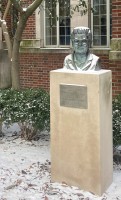Written By: Jerret Barker – Collections and Education Intern
Just outside the north entrance, a bust of Alice Nichols (1906-1994) greets visitors to the David Owsley Museum of Art. This bespectacled figure served as head of the art department and director of the museum, known at that time as the Ball State Teachers College Art Gallery, for 25 years, from 1948 to 1972.

The sculpture of Alice Nichols located just outside the museum’s north entrance.
At the time of Nichols’ arrival, the items found within the Ball State Art Gallery were mostly traditional and shunned any modern art. Nichols, who had studied with modernists and abstract artists during her time as a student and freelance artist, strived to modernize the collection. With the limited funds available, Nichols bought modern sculptures and prints as well as arranging exhibitions featuring the latest developments from Chicago and New York. According to Nichols, “The gallery should no longer be looked upon as a static repository but rather as a dynamic experience. The walls cannot be moved but the unchangeable quality should end there.”[i]
Nichols’ predilection for contemporary pieces immediately put her at odds with the Muncie Art Association and the Ball Family. As there were no galleries dedicated to changing exhibitions at the time, her exhibitions displaced the items originally donated by Frank Ball in 1936. Her agenda alienated members of the Association, whose traditional role of arranging the exhibits at the college gallery had been stripped away. Nichols even rebuked an inquiry about the Gallery’s interest in receiving early Italian art. She also dismissed the sculptures Frank C. Ball had purchased for the sculpture court as “garden sculpture” and suggested that they be placed around the campus in outdoor settings. In response to these rapid changes and Nichols’ taste in art, Elisabeth Ball called her a “wild woman.”[ii]
However, few would argue with Nichols’ commitment to using the collection as a valuable teaching resource. Perhaps Nichols’ dedication to the museum’s role in student education can best be described by her quote, “the gallery must do more than provide ‘things to look at.’ It must make each person who enters hesitate mentally and emotionally long enough to realize that he is experiencing something.”[iii]

Alice Nichols about 1950 (Ball State University Archives and Special Collections).
Nichols’ commitment to education can be seen in a multitude of ways. When the student center left the Fine Arts building and relocated to its present location, Nichols renovated the rooms and created lounges, allowing students to study modern furniture design. She initiated art classes for children in the gallery each Saturday morning, with art education students teaching the classes. Nichols herself taught classes in painting, art history, design, and art education. She also invited contemporary artists to teach in the art department during the summer. These popular classes developed friendly relationships between the artists, campus, the community, and Nichols. Some of these artists would then gift or sell their works at a reduced price, which continued to expand the collection.
Believing that art was essential to life and an enriching experience, Nichols began the Ball State Drawing and Small Sculpture Show in 1955, the first national juried exhibition of such artwork. This contest received entries from 15 states and allowed students and the local community to see contemporary artwork from around the United States first-hand. Over time, the shows continued to increase in size, with some years receiving up to 1,400 submissions from nearly every state.
Deciding to spread art appreciation beyond Ball State’s campus, Nichols developed traveling shows with art in specially designed boxes that could be mounted for display in almost any situation. These exhibits were sent to schools and art organizations throughout the state. In order to reach a large number of Delaware county residents, Nichols devised the Artmobile, a trailer-like vehicle that had been converted into a miniature art gallery. The interior was arranged to accommodate both two-and three-dimensional works of art on loan from the Art Gallery. The art department and Muncie Art Association provided docents. The Artmobile carried its riches to the schools of the city and county and parked in the Delaware County Fairgrounds. During the first year alone, 18,000 students and 7,000 adults experienced the artwork on display.
In 1972, the last year of her directorship, the gallery was formally accredited by the American Association of Museums, thus validating her dedication to art and education.
In 2008, John Surovek, a former student of Nichols and part of the 1968 graduating class, commissioned artist Tuck Langland to sculpt the portrait that now resides just outside the museum. Surovek, now an art dealer in Palm Beach Florida, said he “owes everything” to Nichols and her continued support during his college years.[iv] Indeed, there are countless other Ball State graduates who have shared their admiration for Alice Nichols in the years since her retirement.
[i] Blume, Peter F. Ball State University Museum of Art at 75 (Ball State University Museum of Art, 2011), 34.
[ii] Blume, Peter F. Ball State University Museum of Art at 75 (Ball State University Museum of Art, 2011), 35.
[iii] Griner, Ned. H. The Magnificent Benefactors: The History of the Ball State University Museum of Art (Ball State University Museum of Art, 2002), 24.
[iv] Werner, Gail. “Alumnus commissions sculpted portrait of his favorite Ball State educator, Alice Nichols,” Ball State News Center, April 3, 2008.
Comments:
My parents (Barb and Keith King), were art students when Alice was there, and took us little kids to meet her at her place once. She was awesome! So very friendly, signature silver short hair, mom and dad obviously revered her. I’m so glad for that experience. 💚
Oh that’s wonderful! Thank you for sharing & also for reading <3